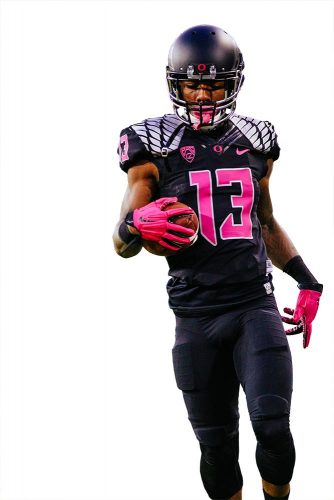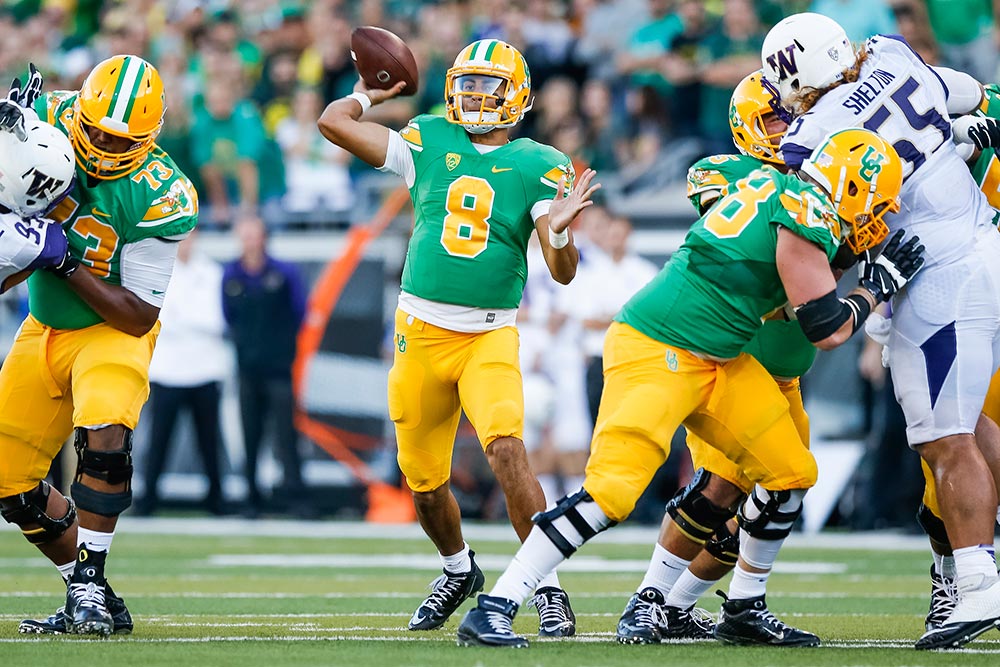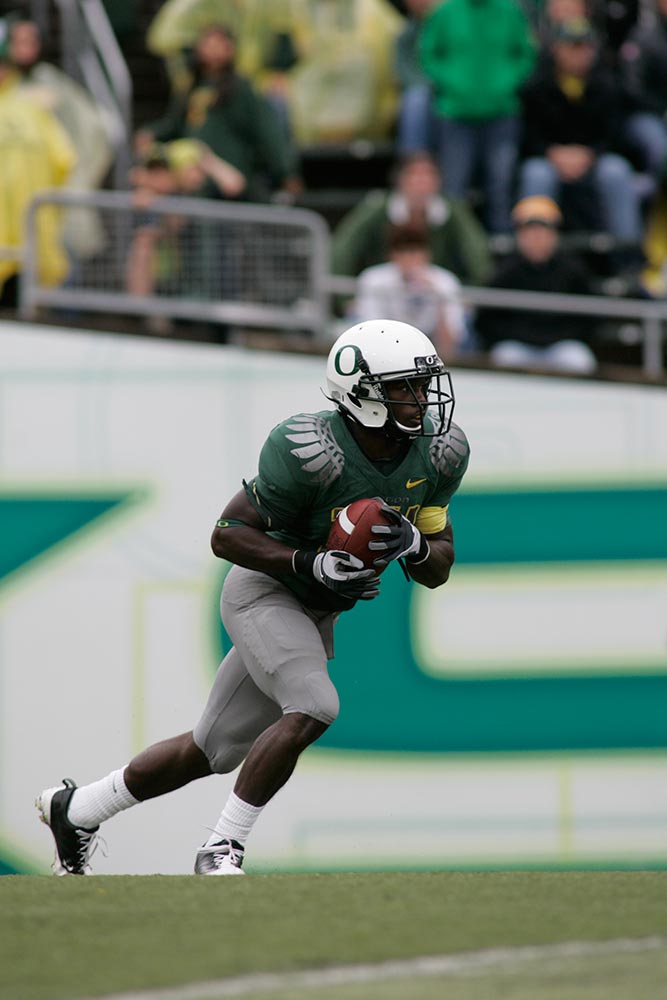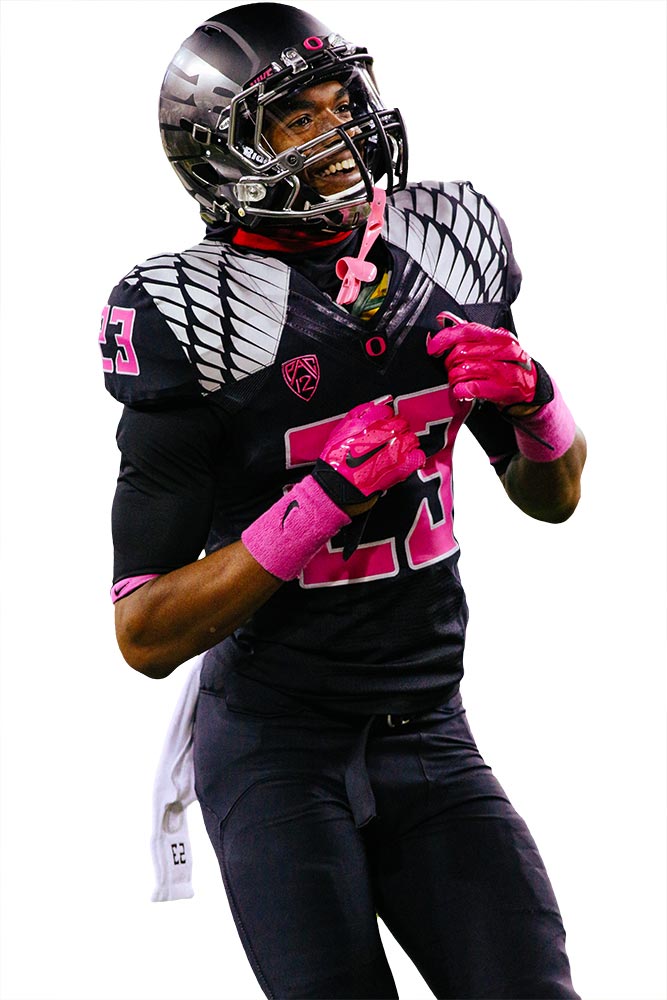
Tradition has a scary mascot. Tradition wears three colors. Tradition practices at “half speed.” Tradition milks the clock. Tradition punts on fourth down. Tradition eats turkey on Thanksgiving. TRADITION NEVER CHANGES. CHAMPIONS DO.
Emblazened on the wall of the University of Oregon Moshofsky Center — the first indoor practice facility on the West Coast — this mantra calling for the complete abandonment of tradition could have been written about the Ducks uniforms.
The Nike-Ducks partnership has revolutionized the cycle of change for uniforms in college athletics. During the 2013 season, Oregon wore seven unique jerseys and six unique helmet and pant designs — compare this to the one home jersey and one away jersey from the pre-Nike games of the early ’90s.
For the UO, change has become the tradition. Long-established institutions like the University of Alabama or Notre Dame, both with more than a dozen National Collegiate Athletic Association (NCAA) football championships, have established tradition over generations. But since the UO founded its football program in 1894, the Ducks have yet to win a championship. Before Oregon unexpectedly won the conference and made it to the 1995 Rose Bowl, UO had won just three postseason games.
 |
| Oregon wore yellow helmets, kelly green jerseys and yellow pants Oct. 18, as seen here on quarterback Marcus Mariota, paying homage to the 1994 design. |
 |
| Kenjon Barner |
 |
|
B.J. Kelley. Photo by Trask Bedortha.
|
The uniform trend has not gone unnoticed: rapper Drake wore a black and a white Oregon football jersey and two different pairs of Nike “Oregon Ducks” Air Jordan shoes while performing in Ridgefield, Washington. And as of the Sept. 22, 2014, issue, Ducks quarterback Marcus Mariota has appeared three times in uniform on the cover of Sports Illustrated.
National attention to the recent changes at Oregon has already provoked countless athletes to look more critically at Eugene — despite its rainy climate and lack of football history — as a legitimate destination for collegiate recruiting.
The UO’s innovative uniforms coupled with hundreds of millions of dollars in athletic infrastructure has helped increase worldwide exposure to the Ducks.
“What Oregon stands for is not standing for anything,” Paul Lukas, a columnist who writes about uniform design for ESPN.com, tells EW. “They have created an air of anticipation so that, if they wear the same thing two or three weeks in a row, that is seen almost as a betrayal by some people. That is what Oregon stands for: constant change.”
Perhaps that’s why the words on the Moshofsky Center (known as the “Mo”) are so important. Oregon may not boast tradition, but when the facility opened in 1998, the football climate in Eugene was about to change.
A State of Change
In 1995, Oregon’s nine-win mark matched the previous year’s 9-4 record for most wins in a season since 1948. The 1996 Cotton Bowl was only the second time in program history that UO reached postseason play in back-to-back seasons.
“You go east of the Cascades and at that time, not many people knew where UO was or even what the difference was between UO and OSU,” says Todd Van Horne, creative director of Nike, who has been with the company for roughly 25 years.
To reach the Rose Bowl in 1995, the Ducks earned a thrilling victory versus rival University of Washington. It was their first trip to the Rose Bowl since 1958, and also marked Oregon’s first conference title in almost 40 seasons.
Oregon’s victory against UW featured an improbable interception by Oregon defensive back Kenny Wheaton, while the Ducks were wearing among the last uniforms featuring the old “Donald Duck” logo. The highlight is still replayed on the big screen at Autzen Stadium before every game.
Moments like this aside, UO football lacked a history of distinction and thirsted for a national identity, which they found by deserting tradition altogether. Just two days before postseason play in 1998, the UO Department of Intercollegiate Athletics held a press conference to announce a new chapter in its timeline: the debut of a new look for the upcoming season with the now signature Nike influence.
“The idea is look great, feel great, play great,” said head coach Mike Bellotti at the university’s 1998 press conference presentation with Nike.
Perhaps the most significant modification was a new logo, still in use today. Rather than the classic looping “U” and “O,” in 2001 the logo evolved into a simple, modern “O” graphic designed by Nike that appears only on helmets. At the time, the sole logo to appear on the jersey itself was a small Nike swoosh. The Donald Duck sleeve logo was removed entirely and colors transformed: The old yellow became more neon, or “lightning,” the mallard green became metallic and a green-black hue was introduced as “dark spruce.”
Twenty seasons after Wheaton’s big victory for UO, Oregon announced that they’d wear a nearly exact replica of the one Wheaton wore, recreated by Nike, while playing Washington on Oct. 18, 2014. Oregon’s overall record before Wheaton intercepted Washington’s quarterback to help the Ducks land a spot in the Rose Bowl was 359-366-34 (.495). But since that game, the Ducks have earned a much more respectable 177-65 (.731) record, including 11 straight wins versus the Huskies.
These days, Van Horne says Nike’s original goal was to build upon the excitement of Oregon’s sudden successes in the mid-1990s. The plan was to define the Ducks as innovators in the NCAA landscape, and the company’s reach extended to facilities like the Mo and the new fast-paced uniform cycle.
“The people that came to Oregon were the people that were pioneers and the ones that took the risks,” Van Horne says. “They were the ones that were untraditional and they were not afraid of change.”
Win The Day
In the midst of mixed reviews for the uniforms from the local community and the national public, Oregon went on to win the Sun Bowl in 1999.
The following season, Oregon had the best record in the conference and won the Holiday Bowl. They won the conference again in 2001, going on to play in the Fiesta Bowl against Colorado — revenge for losses in 1996 and 1998, when opposing fans from Colorado began chanting, “Quack! Quack! Quack!” at the defeated Ducks and their less-than-intimidating Donald Duck gear.
According to USA Today, former athletic director Bill Moos remembered thinking that there would be no “quack, quack, quack” the next time they met. UO won the Fiesta Bowl 38-16.
Oregon’s appearance in college football’s national conversation was now in full swing, and during the 2002 home opener that roar grew louder.
The all-yellow uniforms worn in the home game versus Mississippi State, according to the San Francisco Chronicle, were said to “resemble space suits in a cheap sci-fi movie.” They were also described as “a duck caught in an oil spill” and were called the “ugliest uniform ever paraded on a football field” in letters to the The Register-Guard.
“I have fond memories of when we first launched it,” says Van Horne, who now designs football uniforms for Oregon and many other NCAA and NFL teams. “There were a lot of people saying that those weren’t their colors, that wasn’t their logo. But with that excitement of change, I’ve also known that people in Oregon seem to embrace change pretty quickly.”
The Ducks kept winning. Oregon was the victor in every bowl game that they played from 1999 until 2003.
For comparison, take the University of Maryland, which has a similar contract with Under Armour that the UO has with Nike. When Maryland came out with their flag design uniform on Labor Day 2011, they won. But the Terps only won one more game that entire season, finishing last in the ACC.
“If you look like a clown and you win, you look like a winner,” Lukas of ESPN says. “But if you look like a clown and you lose, you just look like a clown.”
And the Ducks have certainly had their “clown” moments. While national attention for state-of-the-art uniforms is a huge boon to the Ducks, it also ushers in greater scrutiny to the athletic program in general. Who can forget the sucker punch heard around the NCAA when Oregon running back LeGarrette Blount knocked out Boise State’s defensive end Byron Hout in 2009? Then there’s quarterback Jeremiah Masoli, who was kicked off the team in 2010 after receiving a citation for marijuana possession only months after being charged with second-degree burglary for stealing laptops from a fraternity. In 2013, former tight end Colt Lyerla was in headlines for cocaine possession.
The national spotlight shines on more than just players — NCAA recruiting violations unearthed in 2013 took a little luster out of former head coach Chip Kelly’s era. Casting the net wider, the country is watching the entire athletic department as it still makes headlines for the basketball sex-assault scandal that broke last spring.
On the production end, Nike has made progress, but it’s hard to shake a reputation for being, as Business Insider put it in 2013, “a global symbol of abusive labor practices.”
No matter how slick the packaging, these fumbles are hard to forget.
Teamwork
“Obviously, it helps with Mr. Knight being an alumnus and the support that he gives us,” says Kenny Farr, football equipment administrator for the Oregon Ducks. “I know that we’re a priority for them up there, and they make us feel that with their generosity and with the designs and the uniforms.”
According to Farr, who is responsible for facilitating meetings between players and the creative team at Nike to develop uniform concepts, the design process between the UO and Nike is always collaborative. Starting with the early conceptual phase, Nike meets with players to discover their likes and dislikes.
“This goes back to the foundation of Nike. Our mantra is that everything starts and ends with the athlete,” Van Horne says. “We really listen to the voice of the athlete.”
Once Nike goes to work on the concepts, meetings take place every three to six months over the course of a couple years. Van Horne sends a designer to meet with players every four to six weeks.
Jaison Williams, a former art student who played wide receiver for Oregon from 2004 to 2008, was one of the players involved in the design meetings. Van Horne says Williams enjoyed the design aspect of the uniforms. After graduating, he joined the Nike staff and now works under Van Horne as a football designer.
More recently, Ducks wide receiver B.J. Kelley joined the collaboration. “It was a pretty cool meeting,” Kelley says. “You look at a bunch of different options and all of the customizations that are possible. You can throw your ideas out there and design something and see how it looks.” He notes, “We talked about colors and shoe laces and how big everything needed to be, and the location of the ‘O’ logo.”
“You develop a dialogue with them,” Van Horne adds. “You get their insights. We always start with performance. Then, we move into attitude and aesthetics.”
The Ducks often get to see prototypes of new technologies first and may test seven different versions of a cleat or glove to find out if it’s durable, light and comfortable.
If the Ducks are satisfied with the product, it can be rolled out to other college teams, the NFL and the general public.
Oregon, for example, recently played guinea pig for the entire Nike Pro Combat Series. The lightweight padding allows players to protect themselves without sacrificing performance during non-padded drills. Bellotti suggested the idea when he was coaching at the UO.
“The one thing about Oregon that’s great is that we’re not afraid to push the envelope. We’ll entertain any kind of idea, and try it,” Farr says. “Nike knows that, and they’re willing to partner with us to give us what they feel is their best stuff.”
Now various teams across the NCAA are debuting multiple jerseys and helmets in the same season.
“I believe that we are trendsetters with regards to uniforms. We’ve worn chrome helmets in the Rose Bowl, and now it’s pretty popular,” Farr says, a reference to uniforms such as the new metallic helmets with chrome facemasks University of Southern California wore versus Colorado on Oct. 18. “You see five or ten teams with some variation of a chrome helmet.”
In 2011, then UO head coach Chip Kelly said in a press release that the Nike-Oregon partnership was the “gold standard when it comes to merging science and innovation with athletic performance.” The uniforms that his team wore in the Rose Bowl used a breathable “Chainmaille” mesh and 11 different materials in the jersey and pants.
In the glistening Pasadena sun, the Ducks went on to defeat Wisconsin and earned their first Rose Bowl victory since 1917. Though still not a national title, the win was a huge leap forward for UO.
The Cost of Winning
In 2003, the UO signed a seven-year apparel deal with Nike. When that contract expired in 2010, the UO extended it until 2018, a move worth $22.7 million.
An uncensored copy of the contract was released to The Oregonian under order from the state attorney general in response to a public records request. The deal includes $2.5 million worth of gear per year as well as $750,000 in cash and $200,000 in “extra gear.”
This is trumped by Michigan’s contract with Adidas, which is valued at $60 million over eight years — or $6 million per year in cash and products combined. Nike pays University of Texas $5.76 million per year, more than twice the amount given to the Ducks.
But with help from Nike founder Phil Knight, change at the UO was not limited to uniforms. Between 1996 and today, Knight has reportedly contributed several hundred millions of dollars in donations to the UO athletic department. And after the UO announced a fundraising goal of $2 billion on Oct. 17, more money is on the way.
Knight has signed off as the principal donor for a laundry list of projects including $90 million in renovations to the football stadium, $10 million for the Athletic Medicine Center, $227 million for the new Matthew Knight Arena and $68 million for the Hatfield-Dowlin Complex football operation center. Knight also donated to the John E. Jaqua Center for Student Athletes that reportedly cost $41.7 million. That’s in addition to the $15 million to build the Moshofsky Center. Since the center’s opening in 1998, the Ducks have won 10 bowl games — only missing postseason play in 2004.
“There might be kids internationally or on the other side of the country that might not be able to point out Oregon on the map,” Farr says. “But they know Oregon because of flashy uniforms.”
That was certainly the case for star running back LaMichael James, who famously told the Columbus Dispatch before the 2010 Rose Bowl that the uniforms “get people’s attention” and that he “loved the uniforms” before he got to know more about Oregon’s offense.
James, a recruit from Texas, went on to become a Heisman Trophy finalist while at the UO. Following a loss in the Rose Bowl, under his leadership the Ducks went undefeated in 2010, earning a trip to the 2011 National Championship for the first time in program history.
The Ducks lost that game and they are still searching for their first title. But the team received even more international attention for their uniforms, which this time included “volt” yellow socks, Nike Zoom Alpha Talon cleats and “Win The Day” letters running down the middle of the carbon-fiber helmet.
What to Wear Now
In 2014, with the introduction of the College Football Playoff — the system that decides the national champion for the NCAA Division I Football Bowl Subdivision — Oregon was a preseason favorite to make the cut as one of the final four teams.
UO won its first game in convincing fashion, 62-13, vs. South Dakota State. Oregon defied traditional color codes and wore white at home with a white helmet, a “Mach Speed” white jersey, green apple pants and cleats with white gloves and socks.
In their next game versus Michigan State, with ESPN College GameDay in town and as the game broadcasted on national television, the Ducks wore a “Sonic Boom” helmet, silver and yellow gloves along with a yellow jersey, pants, socks and cleats. Oregon won the game, 46-27, against the reigning Rose Bowl champions. UO went on to debut a black “Mach Speed” uniform versus Washington State during a narrow victory on the road. Oregon reprised its 2013 efforts to raise awareness for breast cancer and the Kay Yow Foundation this season, but the team diminished championship hopes after losing to Arizona on Oct. 2 while wearing pink uniforms at home.
Now that the Ducks uniforms have been in the national spotlight for a few years, it would be easy to assume challenges in finding new design combinations. But for inspiration about what to do next, Van Horne simply plans to touch base with the Oregon players.
“Players aren’t bound by anything,” Van Horne says. “They want to set the stage of the next great thing at this university.”
“I think more importantly than the uniforms, if you’re winning games, our fans are happy with whatever we’re wearing,” Farr says.
The jury is still out about whether this season will be remembered as the year the Oregon Ducks win their first national championship. With Mariota on the field, it’s certainly possible, regardless of what he’s wearing.